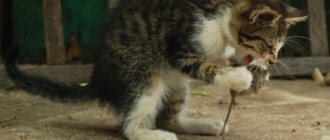Felinologists note that a cat gives its paw only to the owner, in whom he sees the head of the family, and therefore training should not be started if the pet shows signs of neglect. Representatives of the cat family are very capricious and will not comply with human demands unless they receive a reward, so it is better to stimulate your pet with tasty food. You should not start training if you are not sure that you will be able to train your cat every day, since it will take at least 2-3 weeks to get results.
How to Determine Trainability
Horses, elephants, chimpanzees, dolphins and even squirrels are distinguished by their developed intelligence. Among domestic animals, cats and dogs can be considered intelligent representatives. The long-standing dispute regarding which of them is smarter has recently been resolved in favor of the latter. Scientists came to this opinion based on the latest calculations of the number of nerve cells located in the brain tissue.
Cats vs dogs
In the cerebral cortex of dogs there are about 530 million neurons, in cats - about 250 million. Despite such a serious discrepancy in indicators, furry pets are still amenable to learning.
Cat brain structure
There is a version that the main selection criterion for the domestication of representatives of the canine family was their docility and ability to carry out functional commands.
The intelligence of representatives of the cat family has not been fully studied. Much more attention is paid to the analysis of behavioral reflexes of canines. Dogs have well-developed social intelligence. Much better than cats. Therefore, they hunt in a pack, while cats, on the contrary, walk on their own. Since human thinking abilities are also of the social type, people quickly establish contact with their four-legged friends and take longer to master cat psychology.
Cats prefer to hunt on their own
There are about 12 laboratories specializing in studying the brain of dogs. There are no scientific institutions working exclusively in the field of developing the mental abilities of cats. This is explained by the fact that four-legged friends are easier to train and can be more useful to humanity.
Cats are successfully trained
Features of intelligence
These statistics make you think about the feasibility of training furry pets. Despite their wayward and disobedient nature, cats have a number of unique qualities:
- Well-developed sensorimotor intelligence. They are extremely precise in their movements and are able to catch larger game. A lynx, for example, will catch a large hare faster than a fox.
- Good teaching performance. With proper motivation, the percentage of successful tests is almost the same as for dogs.
- Memory ability. They are able to record the events that happen to them and, if necessary, refer to these memories. In addition, compared to dogs, cats have better developed short-term memory - 16 cat hours versus 5 dog minutes.
These encouraging facts indicate that furry pets have the ability to perform various tricks.
The tendency of cats to obey commands is determined during the game
Stunt Abilities
Each animal is individual. Some are easy to train, while others may lack the instinct to comply with human requests. In any case, even the most obedient cat will train only those tricks that he himself wants to learn.
Yu. Kuklachev believes that there are no mediocre cats, there are only unobservant owners. According to his theory, to reveal the natural inclinations of furry pets, you need to do a little spying and learn how to use their abilities.
Before you start training, you need to decide on your cat's talents. If your pet likes to carry toys in its teeth, you should train it to fetch objects. If he spends a lot of time in boxes, teach him to hide on command. If you often jump, develop this skill before performing acrobatic exercises.
Hyperactive animals can be taught to jump through hoops
Breed predisposition
In addition to individual abilities, there are breeds that are more attuned to training than others. Those who are well trained include the following:
- Siamese;
- Abyssinian;
- Bengali;
- savannah;
- American Shorthair.
The Bengal cat quickly learns to perform various tricks
Conversely, there are varieties that demonstrate a complete lack of circus talent. These include the exotic and Persian cats.
Exotic is one of the laziest breeds in the world
Despite these statistics, learning ability can vary among members of the same species. For example, one of the most trained cats in the world does not belong to any of the listed easy-to-train breeds. However, the pet, named Dija, learned to ride and control a skateboard, practice parkour and perform complex commands.
A cat named Deeja
Difficult tricks
Teams for training cats are built according to the principle from simple to complex. If your pet performs easy tasks, you can move on to more complex tricks. As a rule, pets get a taste for it and learn new commands with interest.
- As examples, consider jumping through a hoop and the command “fetch.”
- To perform the first trick, you will need a small hoop or large embroidery hoop.
- The cat must walk or jump over them. The main thing is not to let her get around the obstacle. When the fluffy gets it right, you can raise the hoop higher and higher.
The “fetch” command is more difficult to teach. In this process, much depends on the animal’s temperament. If a cat likes to play with a ball or a toy, then most likely she will bring them to her owner. If not, it is better not to torture the animal, but to move on to practicing another trick. Try to teach him to jump from chair to chair on command or to climb on top of his owner.
How to train a cat to follow commands
Even without training skills, any owner of a furry pet in the process of communication teaches him to respond to his name, use a litter tray and ask for food. If you set a goal, this list can be expanded.
The process of training cats is more complex than dogs. Four-legged friends enjoy following their owner’s commands and seeing his approval. Fluffy pets are more selfish. They prefer rewards and treats to any praise.
You should start training when the kitten reaches 7 months. At this stage, he is already able to understand the requirements of the owner. Training begins with simple commands: “Come to me!”, “Give me your paw” and “Sit!” Then you can move on to more complex ones - “Fetch” and “Stand on your hind legs.”
Compared to dogs, cats take much longer to learn to follow commands.
Trainer's Toolkit
Since animals do not speak human language, alternative means of communication must be used.
Table 1. Communication methods available to cats
| Tool | Description |
| Voice | The animal has sensitive hearing. When a person gives a loud command to a cat, it perceives it as a cry. Stress that arises as a response blocks the ability to fulfill a request. Therefore, you should speak to your pet kindly and avoid an authoritative tone. |
| Pronunciation | A cat can remember about 50 words and associate them with certain actions. Therefore, it is important to be consistent in using voice commands. For example, if the phrase “fetch-fetch” was repeatedly used in a game with a ball, then a single “fetch” will not serve as a signal for the cat to act. |
| Intonation | The pet is well versed in the nuances of the human voice. It is necessary to pronounce each address to him with the same intonation. |
| Promotion | The most important component of any training of representatives of the cat family. The method of stimulation depends on the individual preferences of the pet. If food is planned as a reward, you should make sure that this dish is not part of the animal’s usual diet. |
During the training process, you need to show endurance and patience.
5 tips from experienced trainers
Teaching your cat to perform simple tricks is easy. It is necessary to adhere to the basic rules of training and take into account the individual characteristics of the pet.
Reward is one of the most effective methods of training cats.
General recommendations:
- Create illusions of the game. A cat will never do anything he doesn't like. If you transfer training from an edifying plane to a playful one, your pet will learn the trick faster.
- Synchronize the voice command with the required movement. Even if the cat accidentally made the desired “pa” outside of training time, the appropriate words should be spoken. For example, if a pet puts its paw in the owner’s hand, you need to say “High five!”
- Encourage in a timely manner. One of the main mistakes in cat training is late stimulation. In order to consolidate in the animal’s mind the connection between the action and the subsequent reward, there is no need to postpone the completion of the last point.
- Choose your verbal praise wisely. You should not encourage your pet with phrases that are familiar to him. For these purposes, you need to choose an expression that is not used in everyday life.
- Do not punish or scold your pet. Cats are not naturally submissive. The animal does not draw a parallel between educational measures and failure to fulfill a request. Instead, it will begin to hate its owner and stop responding to any commands.
When training cats, you should not show authority. The pet must decide for himself what he wants to do during training.
Swearing and assault are contraindicated
Bottom line
When the dog understands the command well, you can move on to more complex exercises. You can pronounce the command much faster or ask the dog for a paw when he is in a standing or lying position. And also some dog handlers do not extend their hand to the dog at all, but give the command. Then the animal will hold the limb in the air, which will have a beneficial effect on the development of motor skills.
Usually, after 1 or 2 weeks of regular exercise, the pet perfectly masters new skills and thereby pleases its owner.
After the command is firmly ingrained in the dog’s memory, this exercise should be constantly repeated, even if the arsenal of commands is replenished very often. In this way, the animal can develop motor memory for the necessary movements. It is only necessary to adhere to clear training instructions, and also not to violate the above recommendations, and then the owner can count on the result that he expected. But it is worth remembering that you need to have a lot of patience, since the command may not always work out on the first try. This is why it is necessary to devote proper time to your pet so that it reciprocates.
Stock up on treats
For training, you will need a supply of your favorite food, cut into small pieces. This should not be everyday food, but something special that the mustachioed pet adores.
The training begins with the command “Give me your paw”, after which you need to touch the cat’s paw. Regardless of the result, treat the animal with a treat. This phrase must be repeated as many times as necessary for the animal to understand the process. In the cat's mind, a relationship should be formed between the phrase and receiving delicious food.
When the first stage is completed, you can move on to the next. You should sit in front of the animal and say: “Give me your paw.” Then touch the paw and briefly hold it in your hand. Release and immediately reward the pet with food.
It is important not to delay training so that the cat does not become overtired and become nervous. Excessive zeal can lead to abandonment of classes.
Ways of learning
Your pet will respond better to commands in calm and familiar conditions, so it’s best to wait for him in the living room or bedroom. To teach a cat to give a paw, it is recommended to first attract the cat’s attention with a piece of food - this will increase his appetite and have a beneficial effect on training. It is better for the owner to squat or kneel to be face to face with the pet. You need to say to the animal in a confident tone: “give me your paw,” and then grab it by the pads yourself. Then you should give your pet treats again. This procedure must be repeated every day so that the pet remembers the algorithm.
The next step is to give the command and extend your palm. If the pet twitches even a little, then you need to grab it by the pads. Regardless of whether the cat gives his paw or not, he needs to be encouraged. After a few sessions, the animal will begin to independently extend its paw, rising on its hind legs to get a treat. However, you need to hold out a clean palm that does not smell of food, otherwise the pet will be distracted by the smell and begin to lick your fingers. To speed up the training process, felinologists recommend buying a special clicker at a pet store. An alternative is to download a loud signal to your phone, which you need to turn on before the command. The cat must remember the relationship between the sound and receiving the treat.
How to give a paw: step-by-step instructions
With the right motivation, any cat can be taught basic tricks. The success of training is determined by the animal’s tendency to concentrate. Young pets easily learn the lessons they have learned, while kids get tired quickly.
A cat can learn to follow many commands. “Give me a paw” is the simplest.
Step 1: Familiarize yourself with the clicker
The use of this device as an alternative to voice signals has a number of advantages. Most command words a person uses every day, regardless of whether they are intended for training or not. As a result, the pet does not perceive them as a call to action. But the cat quickly establishes a connection between clicking the clicker and receiving a reward. This significantly speeds up the training process.
A clicker is an effective training tool.
The main advantage of a clicker is that the click it produces is associated exclusively with reward. In everyday life, the animal does not hear such sounds
The device is a plastic device with a thin metal plate inside. When pressed, it makes a characteristic sound. Available for free sale at any pet store. If it is not possible to purchase a clicker, you should download a special application on your phone.
Step 2. Choose a reward method
Find out the type of treat your cat likes the most. These animals are very picky and difficult to please. You should purchase several culinary delights and settle on one.
Treats for cats
A tasty dish should not be repeated in your daily diet. Substitution of delicacies is not advisable.
Step 3: Set your training time
The training schedule should coincide with the pet's resting phases. During training, the cat needs to be in a relaxed and attentive state, but not sleepy. You should observe the cat and calculate the optimal period of time for training. It is necessary to find a place in the apartment where there will be no distractions or irritating factors. This will allow the animal to concentrate solely on the learning process.
Immediately after waking up, after a meal, or late in the evening is not a good time. It is recommended to train before feeding, since a hungry animal reacts more actively to the delicacy.
Training should take place at the same time
Step 4. Development of a conditioned reflex
When your pet is ready to train, press the clicker and give him a treat. Repeat this sequence of actions for 5 minutes.
Due to the fact that cats are not able to concentrate on one action for more than 5 minutes, it is not advisable to prolong classes.
If your pet does not respond to the device and food, there is no point in continuing training.
One of the most important stages of training is for your pet to establish a connection between a click and a reward.
Step 5: Repeat the workout
After several hours, the lesson should be repeated. If necessary, you can conduct up to 3 workouts per day.
Each animal learns at its own pace. Most people learn the relationship between treats and clickers after a few 5-minute blocks.
You can find out whether your pet feels a connection between the click and receiving a treat by looking at it. If, after the characteristic sound, the cat looks at the owner with impatience, expecting a treat, the desired result has been achieved. In addition, she will lick her lips while looking at the device.
Repetition is the mother of learning
Step 6: Connect Voice Command
When the animal associates the click with a reward, you should complicate the task:
- Click on the clicker and give your pet a treat. This will refresh his memory of the relationship between food and click.
- Elevate the cat's limb. To make the animal remember the lesson faster, it is advisable to always grab the same paw.
- Holding the paw in your hand, make a clicking sound, say the command “High Five” and give a treat.
- Release the animal and stroke the scruff of the neck.
Praise and gentle stroking should complete each activity.
The command “High five!” should be introduced after the cat gets used to the clicker
Step 7. Consolidate what you have learned
The exercise can be performed for 5 minutes. The frequency of execution depends on the animal’s mood.
If during training your pet accidentally raises its paw on its own initiative, you should immediately press the clicker, say a command and give culinary encouragement.
If the cat loses interest in training, you should stop training. Let him walk and continue training.
Praise is an essential element of the learning process
Step 8: Eliminating the Clicker Circuit
Change the sequence of actions. Say the command before pressing the clicker. Wait for your pet's reaction. After this, click and give him a treat. Once the animal begins to give paw regularly, the device can no longer be used.
The main task of this stage is to change the link “clicker - treat” to “voice command - treat”.
In order for a cat to learn a lesson faster, it is necessary for it to enjoy the learning process.
Step 9. Refusal of treats.
The number of delicacies should be gradually reduced. After a few weeks, you can stop rewarding the animal for the trick performed.
From time to time it is necessary to return to culinary stimulation. Every fourth time, for example.
The final stage of training is the removal of food from the training process.
Rules for conducting a training program
In upbringing, the owner needs to show firmness, but restraint. It is unacceptable to use harsh words or apply physical force. Professionals recommend adhering to the basic rules necessary for any training program:
The voice is strict, firm, confident and loud. The dog must feel the strength of the owner and respect him. Each command must be different in intonation so that the animal can distinguish one word from another.
Screaming and swearing are prohibited.
The signal is pronounced 1-2 times, it is important to achieve compliance. If the pet does not understand, they help him by demonstrating with another dog or on his own.
It is important to reward any successful action. If a pet is playing around and doesn’t listen, he is pacified with the safe words “enough”, “quiet”, “bad”, “no”. You cannot hit an animal.
Regular and systematic training is important. You can move on to another command only after practicing and memorizing the first one. Before training, the animal must run and burn off energy; if the pet is tired, the program is ended.
Praise needed:
- firstly, the tone changes to friendly;
- secondly, soft, affectionate words are used;
- thirdly, a portion of treats is given.
Some features
Cats have amazing paws with incredible sensitivity. This is simply why the animal is very careful about various human touches on its limbs. Essentially, this is one of the reasons why a pet cannot be easily trained to give a paw. There are several features that are also worth paying attention to during training:
- The cat's paw is not grabbed, but your hands are simply placed under it. It acts as a support on which the cat can quickly place its paw.
- During training, you should always communicate with your pet in a calm voice. If a command is given, then it is possible to add a little insistence to the intonation, but there is no need to increase your voice or start demanding that the cat complete a feast or other task. If you take this point into account, the pet will understand the seriousness of the mood and, perhaps, learn to give a paw.
- If the cat is in an excited state, it is better to postpone the classes; for some reason, the animal is currently unable to comprehend what is happening.
Training is a process that requires a painstaking and serious relationship. And cat training is no exception.
Mr. Cat recommends: TOP 5 easiest cat breeds to train
Unfortunately, some pets do not pay attention to any commands, much less tricks. But there are also breeds of animals that in a few months can become participants in circus performances. Here is their list:
Here is their list:
Abyssinian
The differences are in heightened curiosity, sociability and fearlessness. Due to their muscular body and long fingers, they perform difficult tricks with ease.
Pets of this breed quickly master many commands and become accustomed to the tray.
Active, fast, playful cats, not afraid of water. Amenable to training, they do not refuse goodies.
Siamese
One of the most loyal breeds, these cats are constantly on the heels of their owner. When having fun, he can make a mess and likes to watch TV. They are easy to teach commands and perform all tricks perfectly.
Savannah
A hybrid that resembles a tabby cat. He has a playful character, often gets rowdy, climbs into cabinets, throws off various utensils, and can grab his leg. It is interesting to train them; they perform all commands with varying difficulties.
The above list of cat breeds that can be trained is quite arbitrary. Even ordinary kittens can become the best trick performers
Therefore, there is no need to focus on a specific expensive breed; it is better to train and educate your pets yourself
Read with this
Training without a clicker
Such tricks should be taught to a cat only if touching the paw does not cause her discomfort. If your pet has recently been declawed, this trick may be painful.
You can teach the “High Five” command without using a clicker.
Sequencing:
- Hold the culinary bait in your fist.
- Allow your pet to sniff your hand.
- Wait until the cat tries to get the food with its paw.
- When the paw is on top of the fist, say the command “High five!”
- Give the delicacy and pet the animal.
After a few weeks, the cat will learn to lift the limb. Since there will be no support, it will appear that she is waving her paw.
What can't you do?
If your pet is unable to perform the exercise despite regular exercise, it is recommended to take a break for 2-3 days or try another command, for example, “lie down”, “stay” or “dance”.
Scolding or shouting at a cat if it does not offer its paw is prohibited. Instead, the owner needs to hug the animal's pads themselves and then give the treats. If you skip the reward stage even once, the cat may completely lose interest in the exercises. Sudden movements, excessively long or strong compression are also contraindicated, as this will increase the pet’s stress. The consequence is often an attack of aggression and an attack on the trainer. Felinologists do not recommend continuing exercise when your pet shows signs of fatigue or boredom. It’s better to have 3-4 short workouts a day than one long one, which will tire your cat.
Source
How to stop a kitten from jumping on the kitchen table
This unpleasant habit is due to the fact that in nature cats love to jump onto elevated surfaces and from there observe what is happening around them. A table for this is an ideal springboard, and if there is also food on it, then the pet will come here more often. This behavior must be stopped immediately, because... it is unhygienic for you and dangerous for the animal (sharp knives, harmful products, etc.).
You can use repellent commands or immediately splash water on the kitten. A few drops of essential oil with a pungent odor and a cut onion will help to keep your pet away from the table. Also, the kitten will give up a bad habit if there are unpleasant objects waiting for him on the table, for example, a baking sheet with water, foil rustling under his paws, or empty tin cans that fall with a roar with every movement.
Pet age
In order for the training of your purring friend to be successful, it is important to start training no earlier than six months. Although it is generally accepted that kittens begin to understand a person from three months, the optimal age for starting training is the interval from six months to eight months.
This is the period when the kitten is really ready to accept human commands, and is already physically developed and very active.
If you start training your pet later, results can be achieved. However, this will take more time and effort. Therefore, the first year of a cat’s life is the best period for teaching it commands and tricks.











